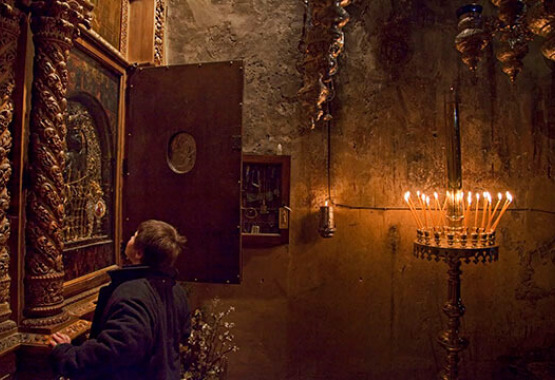
AROUND GREECE
The icon portrays the Virgin Mary kneeling and Her head bent in prayer, pronouncing words written in an open book. Opposite to the Virgin stands the Archangel Gabriel holding in his left hand a lily, the symbolic flower of purity, while the Holy Spirit in the form of a dove descends from heaven.
The art of the Holy Icon is regarded as being older than the Byzantine period, dating back to the early Christian age. Those who studied the origin of the Icon arrived at the conclusion that the Megalohari of Tinos is the work of the Apostle and Evangelist Luke. It is assumed that this icon was so highly esteemed in the Byzantine era it was either hidden or lost around the time of the Muslim invasions.
In our days, the Holy Icon is covered with gold and precious stones placed by those who believe in Panagia, as an expression of faith and gratefulness to Her.
Church of Panagia Evangelistria
Panagia of Tinos, also known as the Megalohari of Tinos (Great Grace) or Evangelistria of Tinos (Our Lady of Good Tidings), is the declared national patron saint of Greece. The discovery of Her Holy Icon coincided with the very first days of the establishment of the Modern Greek State. Throughout the centuries, numerous reports of miracles attributed to the Holy Icon have rendered it the most venerated religious icon in Greece, and the Church of Panagia Evangelistria a globally known sacred place of spiritual pilgrimage and divine worship.
About the Icon
The Church of Panagia Evangelistria in Tinos is dedicated to an icon discovered in 1823. According to the tradition, Sister Pelayia, a nun form the Monastery Kehrovouniou had a vision: the Mother of God appeared asking her to unearth a buried miracle-working icon. Legend has it that the icon was dug up in a field and as soon as it was brought to light a hard protective shield like glass covered it. The men who removed it from the ground penetrated the shield and everyone who touched it was healed. Among the first visitors to Tinos to see the sacred image of the Panagia were Greek War of Independence (1821) heroes Kolokotronis, Miaoulis and Makriyannis.The icon portrays the Virgin Mary kneeling and Her head bent in prayer, pronouncing words written in an open book. Opposite to the Virgin stands the Archangel Gabriel holding in his left hand a lily, the symbolic flower of purity, while the Holy Spirit in the form of a dove descends from heaven.
The art of the Holy Icon is regarded as being older than the Byzantine period, dating back to the early Christian age. Those who studied the origin of the Icon arrived at the conclusion that the Megalohari of Tinos is the work of the Apostle and Evangelist Luke. It is assumed that this icon was so highly esteemed in the Byzantine era it was either hidden or lost around the time of the Muslim invasions.
In our days, the Holy Icon is covered with gold and precious stones placed by those who believe in Panagia, as an expression of faith and gratefulness to Her.


